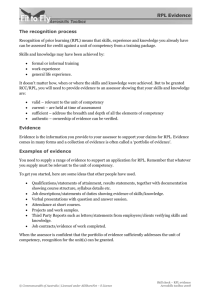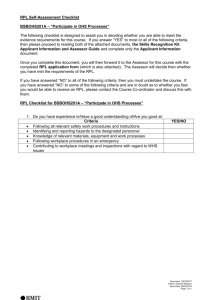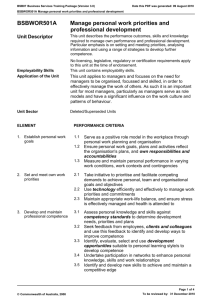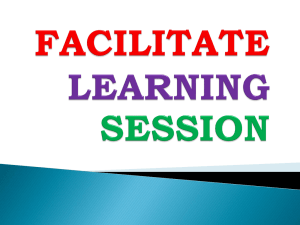TAEASS401B Plan assessment activities and
advertisement
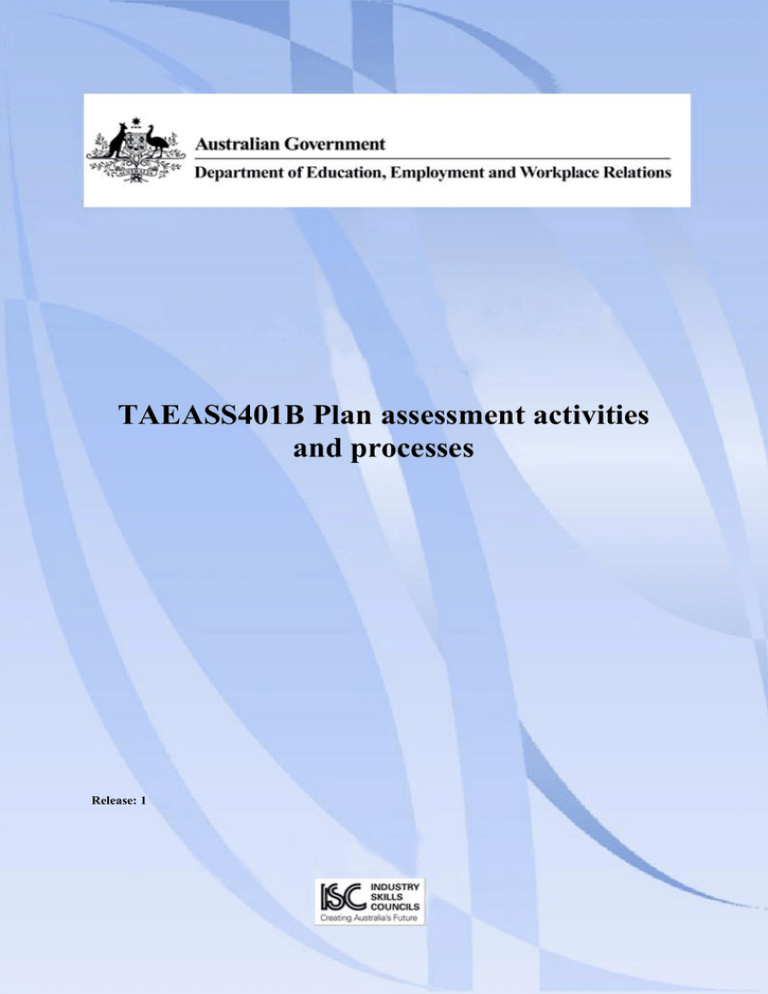
TAEASS401B Plan assessment activities and processes Release: 1 TAEASS401B Plan assessment activities and processes Date this document was generated: 27 May 2012 TAEASS401B Plan assessment activities and processes Modification History Version Comments TAEASS301B Released with TAE10 Training and Education Training Package version 2.0 Unit Descriptor This unit describes the performance outcomes, skills and knowledge required to plan and organise the assessment process, including recognition of prior learning (RPL), in a competency-based assessment system. It also includes the development of simple assessment instruments. Application of the Unit This unit typically applies to assessors and workplace supervisors with assessment planning responsibilities; and trainers or other assessors responsible for planning assessment, including RPL. The unit is suitable for those with an existing assessment strategy which documents the overall framework for assessment. Licensing/Regulatory Information Not applicable. Pre-Requisites Not applicable. Employability Skills Information This unit contains employability skills. Approved © Commonwealth of Australia, 2012 Page 2 of 10 Innovation and Business Skills Australia TAEASS401B Plan assessment activities and processes Date this document was generated: 27 May 2012 Elements and Performance Criteria Pre-Content ELEMENT PERFORMANCE CRITERIA Elements describe the essential outcomes of a unit of competency. Performance criteria describe the performance needed to demonstrate achievement of the element. Where bold italicised text is used, further information is detailed in the required skills and knowledge section and the range statement. Assessment of performance is to be consistent with the evidence guide. Elements and Performance Criteria 1. Determine assessment 1.1 Identify candidate and confirm purposes and context of approach assessment/RPL with relevant people according to legal, organisational and ethical requirements 1.2 Identify and access benchmarks for assessment/RPL and any specific assessment guidelines 2. Prepare the assessment 2.1 Determine evidence and types of evidence needed to demonstrate plan competence, according to the rules of evidence 2.2 Select assessment methods which will support the collection of defined evidence, taking into account the context in which the assessment will take place 2.3 Document all aspects of the assessment plan and confirm with relevant personnel 3. Develop assessment instruments 3.1 Develop simple assessment instruments to meet target group needs 3.2 Analyse available assessment instruments for their suitability for use and modify as required 3.3 Map assessment instruments against unit or course requirements 3.4 Write clear instructions for candidate about the use of the instruments 3.5 Trial draft assessment instruments to validate content and applicability, and record outcomes Approved © Commonwealth of Australia, 2012 Page 3 of 10 Innovation and Business Skills Australia TAEASS401B Plan assessment activities and processes Date this document was generated: 27 May 2012 Required Skills and Knowledge This section describes the skills and knowledge required for this unit. Required skills cognitive interpretation skills to: interpret competency standards and other assessment documentation, including material relating to reasonable adjustment identify opportunities for integrated competency assessment contextualise competency standards to the operating assessment environment, including RPL consider access and equity needs of diverse candidates technology skills to use appropriate equipment and software to communicate effectively with others research and evaluation skills to: obtain competency standards, assessment tools and other relevant assessment resources research candidate characteristics and any reasonable adjustment needs evaluate feedback, and determine and implement improvements to processes literacy skills to read and interpret relevant information to design and facilitate assessment and recognition processes communication skills to discuss assessment, including RPL processes with clients and other assessors interpersonal skills to: demonstrate sensitivity to access and equity considerations and candidate diversity promote and implement equity, fairness, validity, reliability and flexibility in planning an assessment processes. Required knowledge ethical and legal requirements of an assessor competency-based assessment, including: work focused criterion referenced standards based evidence based different purposes of assessment and different assessment contexts, including RPL how to read and interpret the identified competency standards as the benchmarks for assessment how to contextualise competency standards within relevant guidelines four principles of assessment and how they guide the assessment process purpose and features of evidence, and different types of evidence used in competency-based assessments, including RPL rules of evidence and how they guide evidence collection different types of assessment methods, including suitability for collecting various types of evidence Approved © Commonwealth of Australia, 2012 Page 4 of 10 Innovation and Business Skills Australia TAEASS401B Plan assessment activities and processes Date this document was generated: 27 May 2012 assessment instruments and their purpose; different types of instruments; relevance of different instruments for specific evidence-gathering opportunities. Approved © Commonwealth of Australia, 2012 Page 5 of 10 Innovation and Business Skills Australia TAEASS401B Plan assessment activities and processes Date this document was generated: 27 May 2012 Evidence Guide The evidence guide provides advice on assessment and must be read in conjunction with the performance criteria, required skills and knowledge, range statement and the Assessment Guidelines for the Training Package. Overview of assessment Critical aspects for assessment and evidence required to demonstrate competency in this unit Context of and specific resources for assessment Evidence of the ability to: plan and organise the assessment process on a minimum of two occasions collect evidence that demonstrates: documented assessment plans having covered a range of assessment events catering for a number of candidates different competency standards or accredited curricula an RPL assessment contextualisation of competency standards and the selected assessment tools, where required incorporation of reasonable adjustment strategies development of simple assessment instruments for use in the process organisational arrangements. Evidence must be gathered in the workplace wherever possible. Where no workplace is available, a simulated workplace must be provided. Assessment must ensure access to training products, such as training packages and accredited course documentation. Method of assessment Guidance information for assessment Approved © Commonwealth of Australia, 2012 Page 6 of 10 Innovation and Business Skills Australia TAEASS401B Plan assessment activities and processes Date this document was generated: 27 May 2012 Range Statement The range statement relates to the unit of competency as a whole. It allows for different work environments and situations that may affect performance. Bold italicised wording, if used in the performance criteria, is detailed below. Essential operating conditions that may be present with training and assessment (depending on the work situation, needs of the candidate, accessibility of the item, and local industry and regional contexts) may also be included. Purposes of assessment/ RPL recognising current existing competence of candidates determining if competence has been achieved following may include: learning establishing candidate progress towards achievement of competence determining language, literacy and numeracy needs of candidates certifying competence through a qualification or Statement of Attainment licensing or regulatory requirements. Context of assessment/ RPL may include: Organisational, legal and ethical requirements may include: Approved © Commonwealth of Australia, 2012 environment in which the assessment/RPL will be carried out, including real or simulated workplace opportunities for collecting evidence in a number of situations relationships between competency standards and: evidence to support RPL work activities in the candidate’s workplace learning activities who carries out the assessment/RPL. assessment system policies and procedures assessment strategy requirements reporting, recording and retrieval systems for assessment, including RPL quality assurance systems business and performance plans access and equity policies and procedures collaborative and partnership arrangements defined resource parameters mutual recognition arrangements industrial relations systems and processes, awards, and enterprise agreements Australian Quality Training Framework registration scope human resources policies and procedures legal requirements, including: Page 7 of 10 Innovation and Business Skills Australia TAEASS401B Plan assessment activities and processes Date this document was generated: 27 May 2012 anti-discrimination equal employment opportunity job role, responsibilities and conditions relevant industry codes of practice confidentiality and privacy requirements OHS considerations, including: ensuring OHS requirements are adhered to during the assessment process identifying and reporting OHS hazards and concerns to relevant personnel. Benchmarks for assessment/RPL may include: Types of evidence may include: criterion against which the candidate is assessed or prior learning recognised, which may be: competency standard/unit of competency assessment criteria of course curricula performance specifications of an enterprise or industry product specifications. direct indirect supplementary. Rules of evidence ensure that evidence collected is: Assessment methods are the particular techniques used to gather evidence and may include: Approved © Commonwealth of Australia, 2012 valid sufficient authentic current. direct observation, for example: real work/real time activities at the workplace work activities in a simulated workplace environment structured activities, for example: simulation exercises and role-plays projects presentations activity sheets questioning, for example: written questions, e.g. on a computer interviews self-assessment verbal questioning questionnaires oral or written examinations (applicable at higher AQF levels) portfolios of evidence, for example: Page 8 of 10 Innovation and Business Skills Australia TAEASS401B Plan assessment activities and processes Date this document was generated: 27 May 2012 collection of work samples compiled by candidate product with supporting documentation historical evidence journal or log book information about life experience review of products, for example: testimonials and reports from employers and supervisors evidence of training authenticated prior achievements interview with employer, supervisor, or peer. Assessment plan may include: Simple assessment instruments may include: overall planning document describing: what is to be assessed when assessment is to take place where assessment is to take place how assessment is to take place. instruments developed by an assessor as part of formative or summative assessment activities, including: profiles of acceptable performance measures templates and proformas specific questions or activities evidence and observation checklists checklists for the evaluation of work samples recognition portfolios candidate self-assessment materials instruments developed elsewhere that have been modified by the assessor for use with a particular client group. Available assessment instruments may include: Map assessment means: commercially available instruments those created by others inside the registered training organisation. showing a clear relationship between the evidence and the requirements of the unit. Unit Sector(s) Assessment Approved © Commonwealth of Australia, 2012 Page 9 of 10 Innovation and Business Skills Australia TAEASS401B Plan assessment activities and processes Date this document was generated: 27 May 2012 Custom Content Section Not applicable. Approved © Commonwealth of Australia, 2012 Page 10 of 10 Innovation and Business Skills Australia
